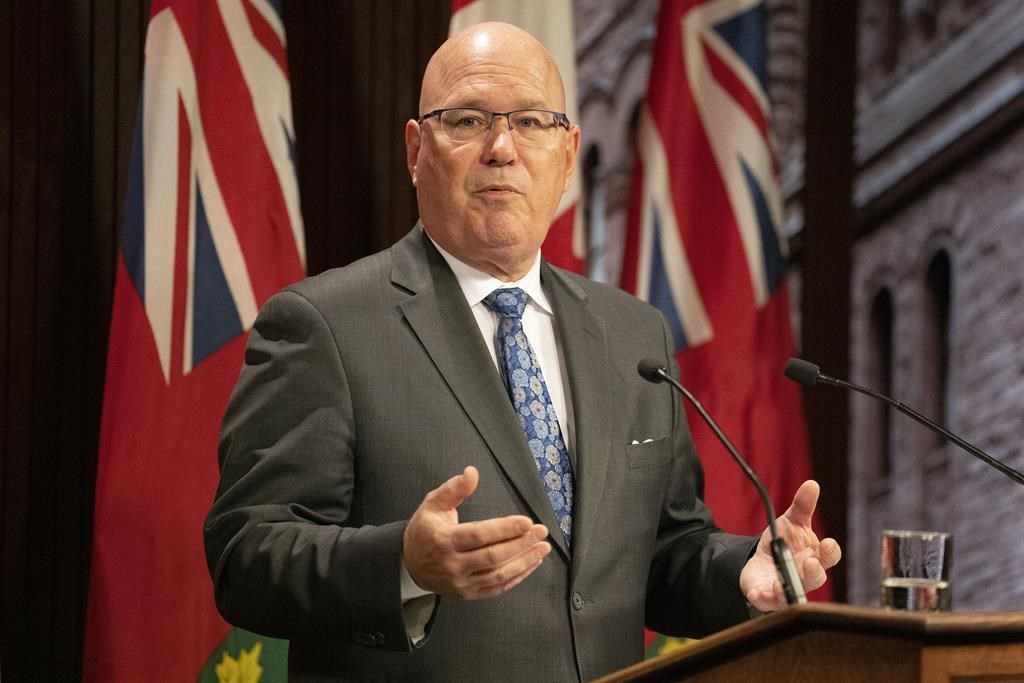TORONTO — Ontario is planning to extend further “strong mayor” powers to the leaders of Toronto and Ottawa, and is reviewing the role of regional governments, in new legislation the opposition decries as antidemocratic.
The bill introduced Wednesday by Municipal Affairs and Housing Minister Steve Clark is part of the government’s push to build 1.5 million homes in 10 years, and comes as its own projections for new home construction were revised downward this week.
“We know government bureaucracy and red tape can sometimes stand in the way of much-needed housing and we’re taking steps to fix this problem,” Clark said at a press conference.
Earlier this year, the government gave so-called strong mayor powers to Toronto and Ottawa, allowing their leaders to override council approval of bylaws, such as a zoning bylaw, that would stymie the creation of more homes. The powers also gave them responsibility for preparing and tabling their city’s budget, instead of council, as well as hiring and firing department heads.
Wednesday’s bill would also let those two mayors propose bylaws on provincial priorities such as housing and enable council to pass them if more than one-third of council members vote in favour.
Ottawa’s new mayor, Mark Sutcliffe, has said he is not in favour of the strong mayor powers, but Clark said Premier Doug Ford is hoping to meet with Sutcliffe soon. Toronto Mayor John Tory has said he supports the new powers.
The legislation would also appoint “facilitators” to assess the regional governments in Durham, Halton, Niagara, Peel, Waterloo and York, and look at the best mix of roles between upper-tier and lower-tier municipalities with an eye to expanding strong mayor powers beyond Toronto and Ottawa.
“The six regions are large, their populations are around 500,000 or more, and represent some of Ontario’s fastest-growing communities where increased housing supply is most desperately needed,” Clark said.
“There’s no sense giving someone strong mayor powers and then have another level of government that stands in the way of getting shovels in the ground faster.”
Clark said the purpose of the facilitators is not to consider amalgamations or recommend the elimination of some upper-tier municipality structures, but he said he won’t “presuppose” the discussions that will take place.
The bill would also reappoint the existing regional chairs in Niagara, Peel and York.
Green Party Leader Mike Schreiner said the legislation is “a frontal attack” on councils’ democratic processes.
“If you look at this bill, this is strong mayors on steroids and it’s actually bringing in minority rule when it comes to affected councils,” he said.
Jessica Bell, the NDP’s housing critic, said nothing in the bill will address affordability.
“This bill is about bulldozing local decision-making so Premier Ford can wield more power,” she said. “It is an affront to democracy.”
Clark already has another housing bill before the legislature that would in part freeze, reduce and exempt fees developers pay in order to spur building.
Municipalities have expressed concerns that would leave them without enough funding to construct supporting infrastructure, but the Association of Municipalities of Ontario is among the people and organizations denied the opportunity to present at the committee considering the bill.
In a written submission to the committee, association president Colin Best said that while there are some positive aspects to the bill, there are many serious concerns.
“Preliminary analysis of the bill indicates the transfer of up to $1 billion a year in costs from private sector developers to property taxpayers without any likelihood of improved housing affordability,” he wrote.
“Members of the committee and all members of the provincial parliament will need to consider in whose interest they govern. Bill 23, as drafted, benefits private interests at the expense of public interests – at the expense of property taxpayers and Ontario’s natural environment.”
Ontario’s fall economic update from earlier this week showed that the province has revised projections for new home construction downward, but Clark said he still believes the province can hit the 1.5 million target.
In the budget, the government projected 84,000 housing starts in 2023 and 87,300 the following year. Now, it is forecasting 76,900 and 77,800, respectively.
Clark said he is “optimistic” it will pick up again, despite external factors keeping new home construction down, such as inflation and interest rates.
Richard Lyall, the president of RESCON, which represents residential builders, said he believes that once inflation cools, demand will pick up again.
“I’ve been doing this job for 30 years, and I haven’t seen this level, this sort of complexity of a problem like this before,” said Lyall, who also mentioned supply chain issues with concrete.
“Once inflation becomes predictable, and rates become predictable, then pricing and forecasting gets more predictable and then you’ll start to see, there are buyers in the woodwork. There’s a lot of cash out there.”
However, once demand for new home construction is renewed, there needs to be a greater supply of skilled tradespeople to build those houses, Lyall said.
The government has been making a big push to attract more people to the skilled trades, including announcing more money in the fall economic statement for a dual credit program that allows high school students to take apprenticeship courses that count toward graduation.
This report by The Canadian Press was first published Nov. 16, 2022.



